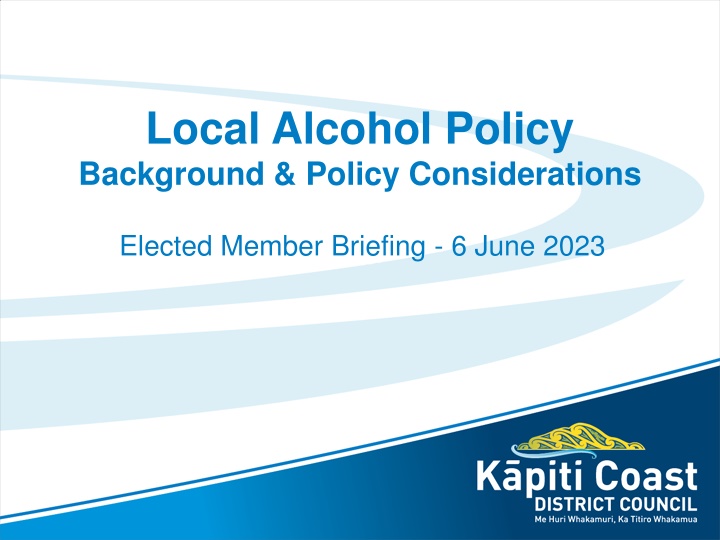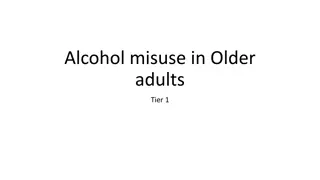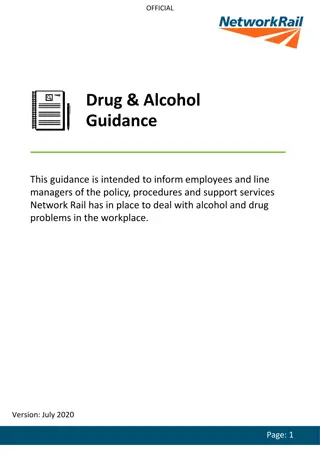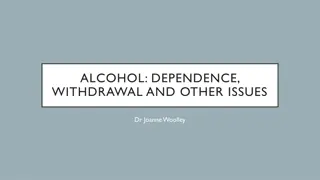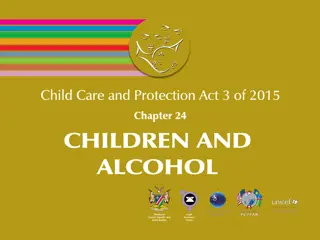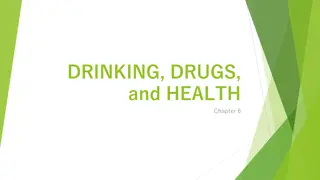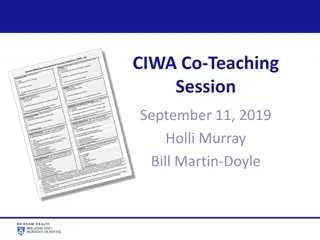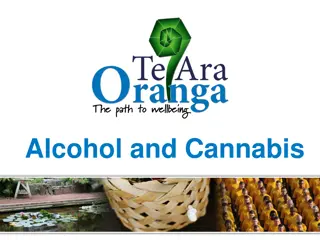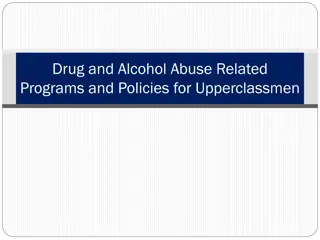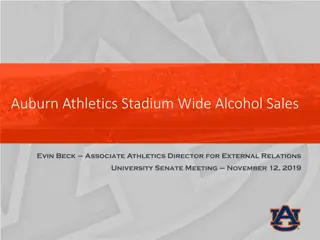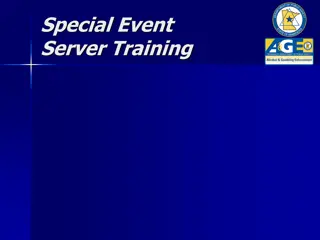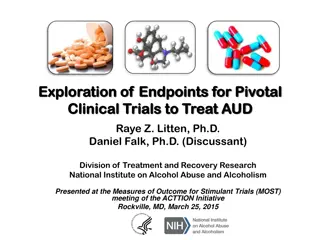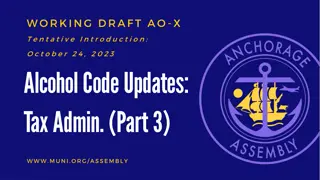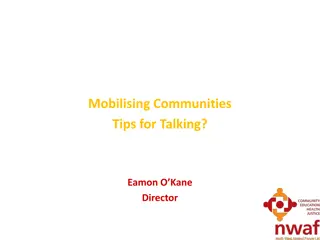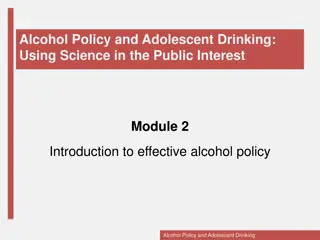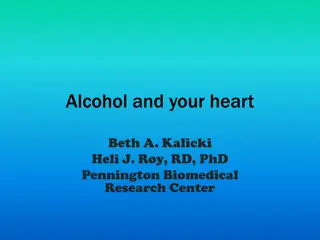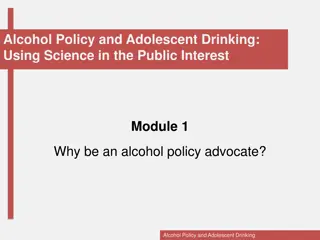Local Alcohol Policy Considerations and Background Overview
This briefing covers the background and policy considerations related to local alcohol policies, including the Sale and Supply of Alcohol Act 2012, harm minimization, appeals processes, community participation, and Supreme Court rulings. It also discusses the current policy context, lack of automatic updates in the SSA Act, and opportunities for councils to advocate for policy changes. The presentation highlights the need for reviewing age restrictions, setting minimum unit pricing, and regulating alcohol advertising.
Download Presentation

Please find below an Image/Link to download the presentation.
The content on the website is provided AS IS for your information and personal use only. It may not be sold, licensed, or shared on other websites without obtaining consent from the author.If you encounter any issues during the download, it is possible that the publisher has removed the file from their server.
You are allowed to download the files provided on this website for personal or commercial use, subject to the condition that they are used lawfully. All files are the property of their respective owners.
The content on the website is provided AS IS for your information and personal use only. It may not be sold, licensed, or shared on other websites without obtaining consent from the author.
E N D
Presentation Transcript
Local Alcohol Policy Background & Policy Considerations Elected Member Briefing - 6 June 2023
What we will cover Recap Policy considerations Alcohol sale, supply and consumption Alcohol-related harm & vulnerable populations Should we develop a local alcohol policy NOTE: SSA Act = Sale and Supply of Alcohol Act 2012
Recap Previous SSA Act considerations: Harm minimisation private member s Amendment Bill Removing appeals process / Restricting alcohol advertising and sponsorship Council resolved to support Community Participation Amendment Bill Removes appeal rights / Resolves the inconsistency between LAPs and the renewal of licences / Widens eligibility of who can object to an alcohol licence application/ Makes DLC hearings less formal Council submitted, generally supporting, but recommending tightening of proposed eligibility criteria for objectors, and in lieu of not removing cross-examination, recommending that lawyers be excluded form DLC hearings Currently 41 of the 67 TLAs have an LAP, but only 35% of population covered (Auckland, Hamilton, Wellington, & Christchurch do not have one) Supreme Court ruling - Auckland now able to adopt its LAP
Current Policy Context SSA Act does not provide any automatic update or review requirements for central government to: Alter age restrictions / Set minimum unit pricing / Restrict alcohol advertising/sponsorship Excise and Excise Equivalent duties: Automatic yearly increase in line with CPI (since 2019) GST additional Act may be changed through Amendment Bills SSA (Community Participation) Bill currently before Parliament, further amendments flagged Only policy amendment provisions in SSA Act are those that support TAs adopting an LAP Other option for Council: Council could advocate strongly for these Council could look at other policy options.
National & Local Policy Levers In place Opportunity to influence/Change National Age restrictions Minimum Unit pricing Tax/Excise duty Yes No Yes Purchase age could be increased Could be introduced Automatic yearly CPI increase to Excise Restriction could be made mandatory Could be lowered for drivers 20yrs & over Could be strengthened considerably Restrict alcohol advertising/sponsorship Voluntary Yes Yes Drink driving limits Health, education, support & addiction policy Local Under SSAA 2012 Licensing based Licence numbers/Density - Location/Proximity - Operating hours - One-way-door - Special condition Under District Plan - Location/Zoning - Size / Floor area Operating hours / Advertising signage Under Local Government Act 2002 - General Public Places bylaws - Place based bylaws (eg Beach) - Available to introduce through an LAP via s.77 provisions Act default provisions Operative District Plan provisions Activity status, conditions and performance standards (10 year District Plan review) - Yes Yes Yes No Working effectively, Council could revisit when bylaws are reviewed and look to introduce wider policy responses to alcohol harm minimisation Liquor ban bylaws General Policy responses
Policy Considerations - Balance An LAP is primarily to support the public good Council needs to balance: evidence, community wellbeing, and public and private benefits Costs / rights and responsibilities the rights of individual drinkers to enjoy the pleasures of alcohol the rights of the alcohol industry to profit from the sale of alcohol the rights of society to protect itself from the harms of alcohol. The Policy response should be reasonable and proportional meeting the test that its elements are: not unreasonable in light of the object of the Act. However, Council may take a precautionary approach: a restriction may be justified on the basis of there being a reasonable likelihood (rather than proof) that it will reduce alcohol-related harm
Purpose & Object of the Act Purpose (s.3): that the characteristics of the Act and its administration are: for the benefit of the community as a whole. The Object of Act (s.4(1)) is that the sale, supply, and consumption of alcohol should be undertaken safely and responsibly; and the harm caused by the excessive or inappropriate consumption of alcohol should be minimised
Alcohol sale, supply and consumption
Licence types and default hours Licence types On-licences (including those endorsed BYO or Catering) Off-licences (including remote sellers and auctioneers) Club licences Special licences (including on-site and off-site) Default hours On-licences Between the hours 8 am on any day and 4 am on the next day for the sale and supply of alcohol for consumption on premises Club licences Off-licences Between the hours of 7 am and 11 pm on any day for the sale of alcohol on premises for which an off- licence is held
Alcohol licenses in Kpiti Community Population Off- BYO licences On- Club licences Total Licences licences licences Paekarkariki / Maungakotokutoku 3,477 5 0 3 2 10 Raumati Beach / Raumati Sth 9,946 4 0 10 3 17 Paraparaumu 11,118 13 1 19 5 38 Paraparaumu Beach 10,974 8 1 11 7 27 Waikanae / Peka Peka 13,788 14 0 11 6 31 10,803 7 0 10 7 24 taki / Te Horo District Totals 60,106 51 2 64 30 147
Alcohol sales and consumption Nationally alcoholic beverages available for consumption in 2022 (+/- from 2021): 498 million litres of alcoholic drinks (down 0 .3%), consisting of: 294 million litres of beer (up 0.5%) 101 million litres of wine (down 5.9%) 103 million litres of spirits and spirit-based drinks (up 3.2%). Equates to: approximately 36 million litres of pure alcohol (ethanol) per year or 8.7 litres per person aged over 15 years 1.96 standard drinks a day (per person aged 18+) (down 1.0%) 1.87 standard drinks a day (per person aged 15+), (down 1.1%) 46% of alcohol is consumed in heavy drinking sessions Consumption has remained relatively steady for wine and beer but has steadily increased for spirits and spirit bases drinks
Alcohol sales and consumption in K piti Approximately $40 million of alcoholic beverages sold in K piti per year From 2021 community survey 35% of respondents indicated that they drank daily 47% drank weekly Wine was the most favoured drink, followed by beer, and then spirits/liqueurs RTD were the least preferred (possibly reflection the large number of older survey respondents)
Alcohol-related harm & vulnerable populations
Sensible drinking recommendations Heavy/Hazardous drinking defined as 6+ standard drinks in one session Beverage Percentage alcohol by volume Above 8%, average 13% 4 to 5% (although some craft beers can be higher) 7% (industry agreed standard) ~180ml (half a can) 1 Standard Drink equivalent 1 x 100ml glass 1 x 330ml bottle Wine Beer Spirit-based drinks (RTDs) Spirits 35 to 46% (Cask whiskey up to 60%) 30ml (single shot)
The Acts definition of Harm (s.4(2)) Harm can be experienced by: the individual society generally, or a community Harm can be directly of indirectly caused, or directly or indirectly contributed to, by the excessive or inappropriate consumption of alcohol Harm includes: any crime, damage, death, disease, disorderly behaviour, illness, or injury, directly or indirectly caused, or directly or indirectly contributed to, by the excessive or inappropriate consumption of alcohol
Kpitis demographic Demographic breakdown Median age: full population 47.9yrs; M ori 26.9yrs Higher than average older population (those 65yrs+) at 24.6% (nationally, 14.3%) For taki: Higher proportion of M ori 31.5% of population under 24yrs Vulnerable populations in K piti Our older population M ori and Pasifika populations Those in higher deprivation areas ( taki (decile 9, Paraparaumu Central (decile 7)
Vulnerability arises from Greater access there are routinely more outlets (particularly off-licences) in areas/communities with high deprivation shorter travel times wider choice price competition leading to cheaper alcohol Contributing socio-economic characteristics Experience of discrimination Co-morbidities, particularly for our older populations Exposure to advertising and wider marketing (ie through sponsorship) particularly affecting younger cohorts significant risk to brain development in younger people binge drinking still prevalent, especially among secondary school students
Alcohol-related harm in Kpiti Police did not identify any particular concerns for a premise/outlet, or for general behaviour Road crashes alcohol contributed to: 68% of road crashes between 2020 and 2022, 84% of crashes resulting in injury Drink-driving offenses Incidences in violent offending and road crashes increases by between 0 and 14 for violent offending and 0.8 and 1.8 for road crashes for every extra licenced premise in the district K piti residents have a high to moderate risk of being hospitalised from alcohol-related conditions Populations at higher risk of alcohol related health risks are taki, Waikanae West, Paraparaumu Beach South, Paraparaumu Central and Raumati Beach.
Alcohol-related harm in Kpiti - Health The total number of hospital admissions associated with alcohol per year over last 10 years has been fairly constant and is not predicted to change dramatically However, acute alcohol-related admissions are on the increase A higher risk arising from partially chronic conditions is related to K piti s higher % older population Wholly Attributable and Partially Attributable Hospital Admissions per 100,000 population (2016-2022) All: Wholly Attributable Crude rate New Zealand 279 Acute: Wholly Attributable Crude rate Chronic: Wholly Attributable Crude rate Decile Decile Decile 183 96 251 6 171 7 80 4 Kapiti District
Community and stakeholder input 2014 survey (n=496) Number of outlets about right Mixed response to capping licence numbers Support for proximity restrictions to sensitive sites Most favoured opening and closing times for: on-licences 12 noon to 12 midnight off-licences: 12 noon (with earlier time for supermarkets) to 10.00pm 2021 survey (n=415) Broad support for additional or amended settings from the default settings in the Act Minimum distances between off-licences and sensitive sites (less concern for other licence types) Limiting numbers of licences strongly supported, particularly in taki, Paraparaumu and Paraparaumu Beach on-licences 10am to 11pm off-licences: 9am to 9pm
Other stakeholder input Licenced organisations were in favour of minimal restrictions, generally not supporting any significant change to status quo Community advocacy organisations: Cancer Society supported more restrictive policies to avoid adding to the health burden to low socio- economic areas taki community expressed deep concern about impact of alcohol on their community and especially tamariki and rangatahi (noting the high proportion of young people in taki)
What can an LAP do Provides for communities to input at the policy level reducing the need for the community to repeatedly challenge licencing applications Has the potential to reduce alcohol-related harms, particularly violence, road crashes, other injuries, and alcohol related disease and dependency: - through reducing accessibility and availability of alcohol: by managing the location and density of outlets, and secondary to this, through price, as closely clustered outlets often compete on price by varying maximum trading hours that may be less (or greater than), the default hours in the Act
Decision precedence Must only cover matters set out in section 77 of the Act licensing matters Reasonable and proportionate Local relevant to the issues of the district or community Precautionary with intent to minimise, protect from alcohol-related harm An ARLA decision has held that: the minimisation sought by the Act s object is not just to simply reduce alcohol related harm, rather, the aim is the minimisation of alcohol related harm; not merely its reduction. Minimisation means reduced to the smallest amount, extent of degree (New Oxford Dictionary). Balanced for the benefit of the community as a whole
Section 77 provisions s.77(1): A local alcohol policy may include policies on any or all of the following matters relating to licensing (and no others): Sub-section How used Policy Impact location of licensed premises by reference to broad areas Can control the location of outlets with respect to local areas and communities. ie: outlets may only be established in town centres (This can also be controlled through the District Plan) Impact: A cross-licence category consideration, to use to control overall availability and accessibility of alcohol to particular areas and communities, reducing easy availability and price competition Balance: Equity of reasonable access and equitable rights to sell a location of licensed premises by reference to proximity to premises of a particular kind or kinds Can control location of outlets in proximity to other outlets ie: require that off-licence premises be at least 500 metres (or some other distance) from each other Impact: By controlling outlet proximity, concentrations of outlets in areas of vulnerable populations (ie high deprivation areas) may be managed. Manages price competition (arising from density of outlets). Balance: controlling outlet numbers while avoiding monopoly b location of licensed premises by reference to proximity to facilities of a particular kind or kinds Can control location of outlets to sensitive sites. ie: could require licensed premises to be at least 500 metres (or some other distance) from schools, health centres, marae etc Impact: Exposure to alcohol product availability, its visibility and advertising, increases likelihood of alcohol use. Reducing exposure of alcohol products to children and other vulnerable communities helps mitigate this. Balance: Equitable rights to carry on trade c whether further licences (or licences of a particular kind or kinds) should be issued for premises in the district concerned, or any stated part of the district Provides the ability to cap for the district, or for a local area or community, the number of licences in total, or the number of a particular type of licence. ie: a cap on off-licences in Paraparaumu Central Impact: A fine tuning of sub-section (a), this provision allows targeting of particular licence categories to reduce availability, price competition and excessive marketing to vulnerable populations. Balance: Fairness and equity and equitable rights to sell d
Section 77 provisions (cont.) Sub-section How used Policy Impact e maximum trading hours Provides the ability to extend or reduce trading hours from the default hours in the Act for different licence types. ie: off-licences could be restricted to a 9.00am to 9.00pm trading window Impact: As with sub-section (a), this provision can be used to control overall availability and accessibility of alcohol. Balance: Equity of reasonable access and equitable rights to sell. The balance between positive and negative impacts on amenity of entertainment precincts. the issue of licences, or licences of a particular kind or kinds, subject to discretionary conditions Provides an ability to specify particular conditions that may be imposed in certain circumstances ie: price advertising in public facing areas (ie. in shop window), could be specified to minimise price competition delivery conditions on an on-line sales outlet Impact: May allow for applications of specific conditions in particular one-off or recurring situations where circumstances require (ie. to ensure a renewed licensed now meets LAP provisions). Balance: Ensuring alcohol sale and supply is undertaken safely and responsibly in specific situations f g one-way door restrictions Provides an ability to impose one-way door restrictions to licences of a particular type or in a particular area. ie a restriction on on-licence bars and night-clubs in a particular area (ie town centre) Impact: In staggering the time customers leave licensed premises, decreases crowds exiting at same time, reduces migration between premises and can help decrease preloading behaviour . Balance: Relies on an effective working relationship between Police, licensees and licensing authority. Restricts personal choice and movement and has had problematic efficacy where instituted
Non-LAP based policy options However, Council could explore other non-LAP actions to support alcohol-harm minimisation: Provide strong, visible support for alcohol harm minimisation Prohibit the display of alcohol related marketing or signage on public footpaths outside or within immediate vicinity of licensed premises Prohibit the display of alcohol related promotion or marketing on any council owned infrastructure, facilities or services Develop policies that require any council-run local events or events that require a council permit, to not allow the marketing and promotion of alcohol Develop policies for groups, clubs or other associations accessing facilities and seeking council grants to eliminate alcohol sponsorship Council can set an example by encouraging their own events or council operated premises and spaces to be alcohol free
Should we vary licensing conditions through a LAP Do you think K piti should have a Local Alcohol Policy If used, should they be applied: across the whole district, or only to identified communities/areas Which of the licensing policy levers do you think are appropriate for K piti location restrictions proximity restrictions: to each other to sensitive sites capping licensing numbers (which types of licence, or all) trading hours (shorter/longer to default) one-way door restrictions special licensing condition
Applying s.77(1) in a Local Alcohol Policy 7(1) (a) Broad areas (b) Proximity to other licences (c) Proximity sensitive sites (d) Capping licences (e) Trading hours (f) Discretio nary condition s (g) One-way- door Paek k riki / Maungakotukutuku Raumati Paraparaumu Paraparaumu Beach / Otaihanga Waikanae Otaki / Te Horo
